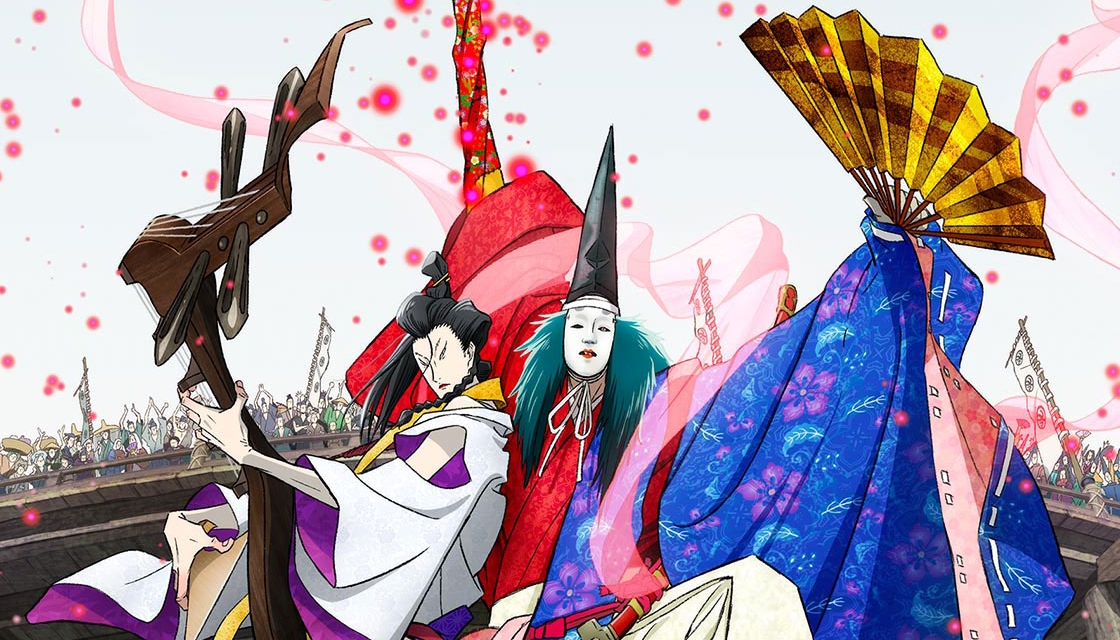If you’re familiar with the work of Masaaki Yuasa, you’ll know that no matter what your expectations are beforehand, you’re bound to be off. This can be said for his newest work, Inu-Oh, an animated rock opera that follows Biwa, a blind musician, and Inu-Oh, a dancer with abnormal physical attributes.
Although the movie title only refers to Inu-Oh, the dancer, the film is mostly about Biwa, who is immediately shown as the driving force of the story. This choice of character direction provides a layer of mystery for the already alien-looking Inu-Oh, who keeps his disproportionate body masked and covered throughout the film.
The film begins at the point when young Biwa becomes blind and then fast-forwards to his adulthood where he is under the wing of a blind shamisen teacher and has found stability among a group of blind storytelling musicians. When Biwa meets Inu-Oh, they have an instantaneous moment of musical chemistry. This leads them to form a band and, breaking with tradition, begin to tell brand new, unheard-of folktales. Almost in the style of what seems like a 14th Century intro to Japanese Rock N’ Roll, the duo delivers electrifying musical and movement performances that ring of old-time legends of our recent past.

The film’s high points are in the live performances, where Inu-Oh’s dance moves are on full display with intricate, well-polished animation. Suppose you’re familiar with classic rock or disco era music. In that case, these concerts will give you a splash of nostalgia as Inu-Oh showcases the history of frontman dances, with familiar struts and iconic shuffles. Each time I realized which moves referenced which iconic legend, I couldn’t help but let out a smirk These homages even happen on a musical level as each new song becomes more and more modern, while still maintaining a retro appeal. It’s as if the duo are chronologically following the trends of late 60’s Rock N’ Roll, and then using that to tease the viewer into guessing what musical flair of the genre will potentially come next.
Sadly, this is where the film’s flaws come into play. Some songs feel long and repetitive, which wouldn’t be so bad if there were not also looped animations used throughout the track making the whole performance feel prolonged. And although many loops sport some minor variations, the lack of diversity in the camera angles and framing creates a static, cold feel that ruins the pacing. In what should be a hot and sweat-filled festival scene, the energy slowly becomes more and more lifeless. In another missed opportunity, there are no panned shots of the large crowd going wild at what would be the equivalent of a feudal Japan version of Woodstock. The lack of time spent on crazed fans means that the scope and madness of the venue are never put on full display
 .
.
Scenes that had fans dancing were impressively animated and a treat to see. Unfortunately, the crowd behind the active dancers had zero interactions with them, breaking the illusion that these individuals we’re supposed to be focused on actually exist. Instead of a fanatic hivemind that looks as if they’re ready to take on the world, the crowd brings on the vibe of a high-budget GIF, used as a background placeholder. By the time any long moving shots appear, the effect, while still breathing life into the setting, will feel sudden and a bit jarring. Add to the fact that some of the songs are quite long and you start to wonder how much of the time spent in these moments will increase the chances of the film ending with a rushed conclusion. Thankfully, I can say, it does not.
In the film's favor, each performance has visual spectacles that go beyond dancing and are a treat for the audience (us included). This brings us to the film’s aesthetics. Just like Yuasa’s other works, this is one pretty film. The characters move smoothly, the flashbacks seem as if they were painted a minute ago, and stronger saturated colors are used resourcefully, making the switch between natural and supernatural tones subtle yet identifiable. This aids a satisfying ending, which I’ve always felt was rare to see in films that follow musical acts, while still giving us the rush of witnessing a musician take a well-deserved leap into stardom.

I don't know about you guys, but there’s just something so special about watching a movie where a band accomplishes success throughout a film. Maybe it’s because we’re able to hear the music and experience it? It could also be that we know the story behind the music and the long journey that came before it. Flaws withstanding, whether it’s your first, second, or tenth viewing, Inu-Oh hits the spot, and for a moment, the sky becomes the limit.
Like many stories between an artist and their art, success doesn’t stick around so easily. Life gets in the way; reality smacks you in the face, and nature reminds the artist of the undeniable force that it is. In Inu-Oh! the viewer will ponder if the story will end in a grounded, final manner, conclude on a spiritual note, or even lead them to wonder if a wholesome finale is possible in this unforgiving world. But just as these unorthodox musicians were smacked out of the blue by fate, so the audience will be by the end of the film.
SCORE: 5.6

